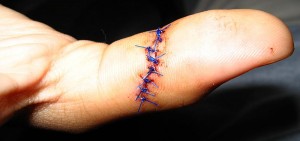Traditional sutures help the healing process by closing and sealing a wound. Now, thanks to some research from scientists at the University of Illinois at Urbana-Champaign, smart sutures can measure skin temperature, deliver heat to a wound, if need be, and perhaps soon provide electrical stimulation or release drugs.
Urbana-Champaign, smart sutures can measure skin temperature, deliver heat to a wound, if need be, and perhaps soon provide electrical stimulation or release drugs.
The development could speed healing for wounds. The electronic sutures, which contain ultrathin silicon sensors integrated on polymer or silk strips, are flexible enough to thread through needles, lace through skin in animal tests, pulled tight and knotted without damaging the effectiveness of the devices.
If skin’s temperature is elevated — indicating that an infection is present — the suture can measure that temperature and deliver heat to the wound site, which aids healing. Eventually, the threads could be laden with devices that would electrically stimulate the wounds, says John Rogers, a professor of materials science and engineering at the university, who invented the smart sutures, reports Technology Review.
“Ultimately, the most value would be when you can release drugs from them in a programmed way,” he says. This innovation could occur when the electronic threads have coatings with drug-infused polymers that would release chemicals when triggered by heat or an electric pulse.
Rogers and his colleagues made the sutures with silicon membranes and gold electrodes and wires that are just a few hundred nanometers thick and patterned in a serpentine shape. The research was summarized in a paper published in the journal, Small. Technology Review explains the manufacturing process:
The researchers first use chemicals to slice off an ultrathin film of silicon from a silicon wafer. With a rubber stamp, they lift off and transfer the nanomembranes to polymer or silk strips. Then they deposit metal electrodes and wires on top and encapsulate the entire device in an epoxy coating.
Two types of temperature sensors are in the sutures. One is a silicon diode that shifts its current output depending on the relative temperature. The other is a platinum nanomembrane resistor that changes its resistance with the rise and fall of the temperature. The micro-heaters are gold filaments that heat up with current passes through them.
The sutures are safe for the body, Rogers says. The challenge in their design was whether they could be flexible. Silicon is brittle so the design was critical. Placing the silicon layer halfway between the top epoxy and the bottom polymer also was important. “When you bend the entire construct, the top surface is in tension and the bottom is in compression, but at midpoint the strains are very small,” Rogers says.
The flexibility has been tested on rats but the temperature sensing and heating capabilities have not yet been tested in animals. The researchers are working on making the devices wireless.
Source: “Smart Sutures That Detect Infections,” Technology Review, 8/24/12
Image by public domain.
